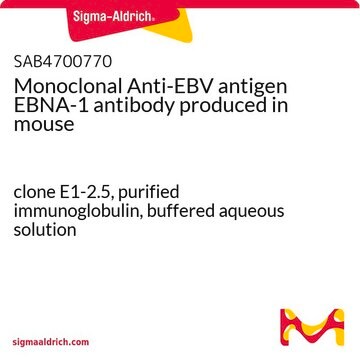General description
The Ubiquitin-like protein FAT10, also known as Ubiquitin D (UBD) or Human Leukocyte Antigen (HLA)-F adjacent transcript 10 (FAT10), is a member of the Ubiquitin-like proteins (UBLs) modifier proteins.There are more than 12 identified UBLs including FAT10, SUMOs, NEDD8, ISG15, UFM1, URM1, ATG12, ATG8, FUB1 and HUB1.2 UBLs share a similar structure and function and all UBLs can be covalently attached to their target proteins via the E1–E2–E3 enzymatic cascade in a similar manner to Ubiquitin. UBLylation is a major post-translational modification that in many cases leads to protein degradation in the 26S proteasome.2
Specificity
Anti-FAT10 antibody specifically recognizes FAT10 from human origin.
Immunogen
synthetic peptide corresponding to the C-terminal region of human FAT10, conjugated to KLH
Application
The antibody may be used in various immunochemical techniques including Immunoblotting and Immunoprecipitation. Detection of the FAT10 band by Immunoblotting is specifically inhibited by the immunogen.
Biochem/physiol Actions
FAT10 is a unique UBL containing a C-terminal GG motif available for activation and conjugation. This motif differentiates FAT10 from ubiquitin and other UBLs the needs to be cleaved from precursors. Furthermore, unlike ubiquitin that requires a poly-ubiquitin chain, the FAT10 can bind the 26S proteasome as a monomer to mediate proteasomal degradation.2-3 Under normal conditions, FAT10 have short half-life, its expression is repressed by p534 and is restricted to tissues of the immune system like thymus, lymph nodes and the spleen. Inflammatory cytokines such as IFN? and TNFa and downstream STAT3 and NF-?B signaling can induce its expression also in other tissues.2-3,5 FAT10 expression is also upregulated and can be increased up to 100-fold in many cancer types including liver and colon cancer HCC, colorectal, ovarian and uterine carcinomas triple-negative breast cancer, bladder cancer, gastric cancer, glioma, pancreatic ductal, adenocarcinoma and osteosarcoma.2,5-6 FATylation has an important role in many cellular process varied from cell maintenance to DNA repair. Understanding FAT10 mechanism and finding its downstream substrates is important to reveal its role in tumorigenesis.1-7
Physical form
Supplied as a solution in 0.01 M phosphate buffered saline pH 7.4, containing 15 mM sodium azide as a preservative.
Storage and Stability
For continuous use, store at 2-8°C for up to one month. For extended storage, freeze in working aliquots. Repeated freezing and thawing is not recommended. If slight turbidity occurs upon prolonged storage, clarify the solution by centrifugation before use. Working dilution samples should be discarded if not used within 12 hours.
Disclaimer
Unless otherwise stated in our catalog our products are intended for research use only and are not to be used for any other purpose, which includes but is not limited to, unauthorized commercial uses, in vitro diagnostic uses, ex vivo or in vivo therapeutic uses or any type of consumption or application to humans or animals.









